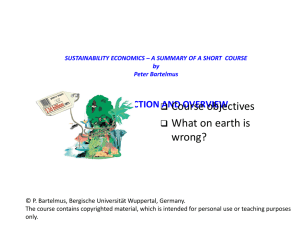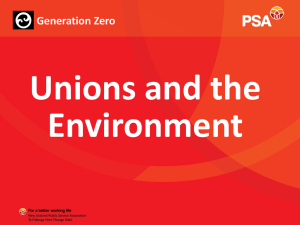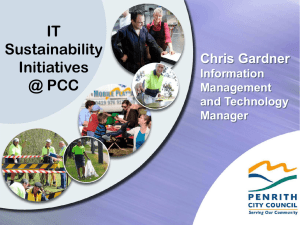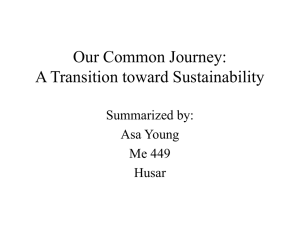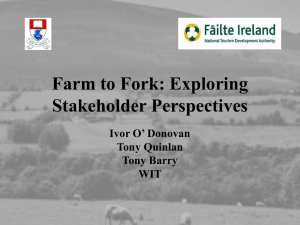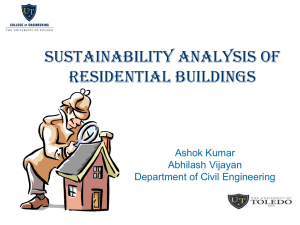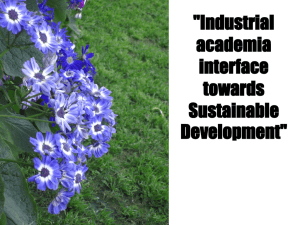True cost accounting
advertisement
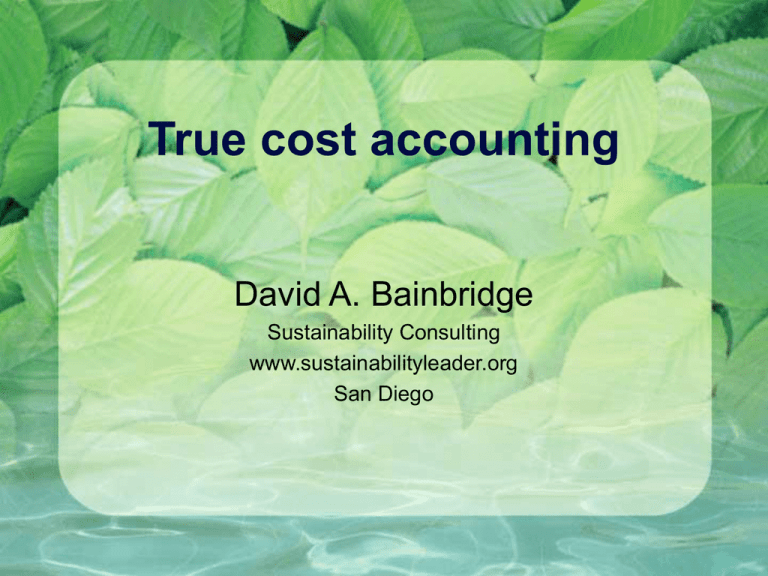
True cost accounting David A. Bainbridge Sustainability Consulting www.sustainabilityleader.org San Diego True Cost Accounting One of the key goals of sustainability reporting and management is improving the accuracy and completeness of accounting This includes current and potential risks, costs and benefits Many sustainability efforts are weak because they fail to consider the financial implications of environmental and social impacts (and risks) - both short term and long term More complete accounting Will require new steps to include: external costs and benefits current and potential liability and risk likely emissions fees or cap and trade market impacts and offsets known or uncertain risks for social and environmental impacts implications of rapidly increasing costs for emissions and resources subsidies, direct and indirect added costs from climate change impacts “Triple Entry” Bookkeeping TCA should not be seen as a separate process It may initially take the form of “triple entry” bookkeeping ($, people, environment) but will soon be fully integrated with operational and strategic management The Global Reporting Initiative offers guidance on overall content but needs improved TCA consideration Change is coming Fortunately, sustainability accounting is getting increasing attention around the world (although the US lags) Major efforts include the International Federation of Accountants (IFAC), the Association of Chartered Certified Accountants (ACCA) and the Accounting for Change project ACCA on Sustainability As financial stakeholders pay more attention to the risks posed and opportunities afforded by these issues, organizations will need to integrate sustainability in all their operations and processes, including accounting Climate change, biodiversity, health, resource shortages, labor rights, human rights, diversity, waste, and outsourcing all have sustainability impacts and financial implications IFAC on Sustainability Unless the accountancy profession embraces sustainability, we will become less and less relevant to society. Nick Shepherd: President, EduVision Organizations that successfully embed sustainability from a strategic perspective tend to convert increased sustainability performance into commercial advantage A strategic sustainability perspective helps develop a better awareness of risks and opportunities IFAC and ACCA IFAC (http://www.ifac.org/) includes 157 members and associates in 122 countries and jurisdictions, representing more than 2.5 million accountants (The IFAC leader this year is an American) ACCA (http://www.acca.org) supports 131,500 members and 362,000 students throughout their careers, providing services through a network of 82 offices and active center The accounting challenge To incorporate environmental and social issues in financial statements in a way that adds value and improves operations And that supports the organization's stewardship role and enables workers/clients/customers to make better decisions regarding environmental and social impacts on assets, liabilities, risk, income, and expenditure Value added A better understanding of financial costs, risks and opportunities leads to action Sustainability reporting adds the most value when it includes cost information that is linked to operations and strategy The goal is to get to the raw material and product level - then good and bad materials and products can be identified Sustainability accounting helps put sustainability reporting to work -- not simply “green” reporting for public relations Ending EH&S as Overhead Many if not most environmental costs have traditionally been considered overhead Attributing costs to products, facilities or services can be very informative because the Bad are often subsidized by the Good Eliminating costly products and operations can improve profitability and reduce risk Amoco Oil found that at one facility the environmental costs were 22% of non-feedstock costs. Waste treatment and disposal were dwarfed by administrative costs, fines, fees, sulfur recovery, maintenance and depreciation of pollution control equipment, and product specification. Payback for improved operations was very rapid! Clarity and Transparency To develop information that matters This falls under the GRI materiality section To understand the value proposition To engage management, workers and stakeholders (writ large) To improve communication in and out Key factors Level of detail Quality of information Clarity of presentation Communication with stakeholders Reporting relevant issues International Accounting Standards Board IAS 37 on Provisions, Contingent Liabilities and Contingent Assets IAS 2 on Inventories IAS 16 on Property, Plant and Equipment: IAS 10 on Events after the Balance Sheet IAS 36 on Impairment of Assets IAS 38 on Intangible Assets other provisions may also be important More factors International Financial Reporting Standards IFRS 3 on Business combinations IFRIC 1 (international interpretation) on Changes in Existing Decommissioning, Restoration and Similar Liabilities IFRIC 6 Liabilities Arising from Participating in a Specific Market - Waste Electrical and Electronic Equipment An entity should disclose the accounting policy adopted r/e provisions for site restoration and environmental rehabilitation Environmental cleanup The very large liabilities for cleanup under provisions of the U.S. Comprehensive Environmental Response Compensation and Liability Act led to considerable work on environmental accounting issues Many small and large businesses (and insurers) have been exposed to high costs and large potential liability for cleanup of environmentally hazardous materials Accountants need to be aware of the disclosure and reporting implications of companies confronted with disposal and cleanup Restoration costs Companies and organizations may also be liable for very large restoration costs These may be required by state or national rules and regulations, legal action or political pressure In Sunburst School Dist. #2 v. Texaco, Inc., 338 Mont. 259, 2007, the Montana Supreme Court reviewed a jury award of $16 million in compensatory damages and $25 million in punitive damages to plaintiffs whose soil and groundwater were contaminated by benzene from a nearby Texaco refinery. The Court, in a new rule, held that they were entitled to restoration damages because personal use of the property gives it value beyond that of the sale price and because restoration damages may be necessary to make whole the owner of personal property Including External Costs Accounting for sustainability includes external costs in operations at the strategic, operational and activity or product level External costs are those that have historically been ignored - such as health impacts of air pollution, costs association with product dissemination in the environment, loss of resources from contamination and a wide range of other costs First discussed by Arthur C. Pigou in 1923 Bainbridge, D.A. 2009. Ch 4. True cost accounting. In Rebuilding the American Economy. Rio Redondo Press. www.sustainabilityleader.org External costs We would like to know the: Source and emissions rates and types Dispersion, deposition, concentration Lifetime, synergistic interactions with other compounds or materials Dose response -- impacts on human health and ecosystems Monetary value of social and environmental impacts If external costs are ignored then accounting results are flawed, and poor decisions are made Impact analysis Impacts can be traced to products, facilities, operations, and maintenance (consumers and commuters) Health and ecosystem impacts can be short term, long term, chronic or catastrophic Global concerns are more often covered than local, and regional problems--but local and regional matter Biomagnification Each step up the food chain can increase concentration about 10 times For a complex food web with many organisms the concentration can be 10*10*10*10*10*10 or 1 million A seemingly safe emission level may be very damaging to the environment and people’s health Ecotoxicity A galvanized roof is low cost and durable, but leaches zinc, which is very ecotoxic Ecosystem damage costs are high even though health risks are low Other common ecotoxic materials include copper, nitrogen, phosphorus, biocides (insecticides, herbicides, rodenticides, etc.), hormones and drugs Systems impacts The cost of sea level rise will be enormous Much productive ag land will be lost Cities will face enormous costs for protection The Dutch anticipate spending $135 billion by 2100 to raise dikes If on-going analysis of sea level rise in the Pliocene appears likely with current GHG emissions rates the increase could be 80 feet Risk - consider BP Gulf Costs Would anyone care to guess the ultimate cost to BP? So far about $14 billion Long term cleanup $30 billion? Total $65-75 billion? This may undercount the true cost to communities and ecosystems by x10? GHG Global heating gas emissions should be tabulated (required for larger emitters now in California) and costed! See California AB32 requirements and http://www.climateregistry.org/ In some countries emissions may be subject to a test that measures impairment of their carrying value if they exceed the amount recoverable from GHG Protocol Corporate Standard or the World Business Council for Sustainable Development GHG Protocol. http://www.ghgprotocol.org/ http://www.accaglobal.com/general/activities/subjects/climat e/newsletter/ Emission costs (Pigouvian fees) Accounting should also report current and anticipated costs for emissions and emissions markets The International Emissions Trading Association provides information on emissions trading and market mechanisms www.ieta.org/ Emissions trading typically restricts the total allowable amount of a pollutant and allows market forces to continually move the allowed emissions to the highest value uses Cap and Trade Costs Several markets exist CO2 prices have been as high as €30 ton, but fell to as low as €8 after the economic crisis California has some regional market development for emissions, including nitrogen oxides (NOx) Straight emissions fees are better, simpler and encourage innovation faster, but cap and trade has been easier to sell A realistic figure for impacts is €40-50 ton CO2 Still to be determined Many of the needed rules for these issues are still in development IASB and FASB have discussed accounting for emissions trading schemes, including how to account for: 1) the receipt of allowances in cap and trade scheme 2) the baseline in a baseline and credit scheme. Resource Risks Environmental accounting should also address risks of resource supply and cost Almost anywhere in the world the availability of water and energy are likely to lead to shortages and price spikes These types of risk should be addressed in strategic planning sections of sustainability and annual reports They may play an important role when considering financial risk and investment opportunities, due diligence in M&A, sales and purchase of facilities, and supply and value chain risk How good are estimates? Although external cost figures are rarely as good as official national accounts data the estimated costs are still very useful Ecological costs are often weakest because of poor understanding! Ecological cost estimates may appear high, but generally underestimate costs because of limited analysis Social costs Some social costs are better understood thanks to more detailed studies Cost can be allocated by manufacturer market share Long term future health and social costs are enormous if lifetime care is involved, as it is for diabetes Current U.S. cost for diabetes is about $130 billion a year An alcohol producer Forum for the Future helped a UK alcohol producer to evaluate their external costs Responsibility was shared equally (customer, seller) Million pounds Ecological costs (6.2) Social costs (52.0) Social benefits (DB adds) 5.0 Current profits +7.4 Net (45.8) We might also consider payroll and multiplier impacts. A major brewery recently closed, only 363 workers. An American cigarette company A similar result is found in examining a major U.S. cigarette producer. Billion dollars Annual profit $1.3 Annual social cost $(13.3) Net profit or loss $(12) Not including environmental costs or social benefits of employment. <10000 employees. An Oil Firm A UK oil company Category Billion pounds Economic capital 1.4 External costs (a wide range) Sustainable value (72) This represents about 8% of UK GDP Figge and Hahn 2004 Irrigated farmland in the NW Subsidies -- not easy or popular to study these often perverse incentives Irrigation cost paid by farmers in the Moses Lake area less than 5% Estimated cost per acre of irrigated land for proposed expansion in the 1970s - $5000 acre for land worth $2000 an acre with irrigation, farmer share just $115 acre Add social and environmental cost for damage to salmon, tribal groups and environment Consider benefits as well Alliant International University Millions Budget spending x multiplier ~$150 Improved earnings of graduates About 50,000 alumni, assume half are still working, earning $20,000 extra per year for UG degree and more for advanced degrees ~$500 Volunteer time $1 Subsidies - Federal and State loan programs ($1?) Environmental costs ($5) Net $645 True Cost Accounting Challenges: Isolating and identifying costs and benefits Limitations of understanding and lack of research Estimates of uncertainty can highlight areas where additional work is needed Even rough estimates can improve activity or product based accounting and add VALUE! Key factors to consider Energy (use and GHG emissions) Water (use and abuse) Resources Wastes Chemicals Ecosystem impacts Health impacts Cultural impacts Energy Fortunately the external costs of energy and key GHG have been studied These can be related to company or organization operations by simply counting the kwh or gallons of oil and gas burned Consider the primary production of electricity (including fuel, power plant and line loss inefficiency, typ. 25% net efficiency or less) External costs should be included in electric car operation (esp. if coal fired electricity) GHG cost estimates Type ExterneE Rural emissions impact €/ton Possible value for US $ton (a wide range possible, local considerations matter) CO2 20-300 40 (cost to avoid zero-$1000+) Sulfur dioxide SOx 5000-7000 18000 (cost to avoid $120-2000+) Nitrogen oxides NOx 4000-8000 10000 (cost to avoid zero-50,000+) Particulates PM<2.5 14000-22000 11000 (cost to avoid $1200-13000+) Volatile Organic Compounds VOC 1400-3000 1500 (cost to avoid $160-2400+) Also other GHG, esp. CFC, HCFC (refrigerants), methane, etc. Impact costs in urban areas can be much higher Global challenges The Millennium Ecosystem Assessment Report provides a good background for understanding and valuing ecosystem services. The Stuff of Life — food, fresh water, timber, and fiber for clothing Protection from extreme weather, floods, fire, and disease. Regulation of the Earth’s climate Filtration of wastes and pollutants. Regeneration of clean air, water, and soil. Inspiration, recreation and spiritual sustenance, and support for a way of life Ecological costs Ecological costs can be best estimated in some cases by considering restoration costs Calculating the costs of ecotoxicity, biomagnification, disruption of communities, or biodiversity loss can be more challenging Cleanup cost, support for rare and endangered species, or other proxy costs can be very high Restoration of damaged land is often in the $20,000-200,000+ per acre range Simply controlling invasive weeds that are benefiting from nitrogen pollution (NOx, ammonia, etc.)can cost $1500 acre/year Risk Management Cash flow risks, such as increased expenditure on measures to reduce emissions, or to purchase allowances should be considered Reputation risk may influence financial ratings, market capitalization and lending options Capital cost risks may develop from more stringent credit conditions as a result of increased credit risk when sustainability accounting is not done Opportunity risk - Investors may also factor an organization's carbon, eco and health related risks in estimates of its future cash flow (DJSI, FTSE4Good, etc.) Regulators, including EPA, can offer regulatory relief to good citizens that report and act sustainably Accounting can help support audacious goals Set big goals, often they are met much sooner than expected once the true costs are counted In many cases staff are simply waiting to be turned loose on improving eco-efficiency and reducing waste True cost accounting can show when these audacious goals are the best cost solution Zero waste goals are now common Zero carbon footprint goals are common Zero net energy use is possible for some firms Goals in Reporting Demonstrate commitment to TCA and sustainable accounting Help ensure that TCA and sustainability are embedded in an organization's activities Show how the organization is doing including (a) broad organization-wide goals, perhaps promoted in the public domain and (b) specific targets and performance measures within an organization's performance measurement framework Contrast with competitors can be good for marketing Business sustainability Many companies and organizations have said that if they had not invested in sustainability they would be out of business today TCA can improve management and add value Reducing operating cost just 5% can make an enormous difference Reducing liability and risk can pay big rewards Over the last 34 years, 3M’s pollution prevention pays program has prevented 2.9 billion pounds of pollutants and saved more than 1.2 billion dollars Supply Chain Supply chain pressure is a key driver of improving sustainability practices and performance. Retailers and producers increasingly expect suppliers to reduce the negative impacts of the components of products and services they provide The demand for an auditable trail and detailed information on impacts is also growing Suppliers are also increasingly subject to standards that include sustainability The early steps of the supply chain in fields, farms, mines are major causes of external costs Ecological benefits Ecological benefits should be included in accounting These may include a variety of Nature’s Services and Natural Capital The value of oxygen generation, water management, air filtration, and recreation can be estimated Forest holdings can also be used as credit for carbon sequestration if they are appropriately managed (The Vatican does this!) Forest holdings or lands may also provide social benefits - recreation, view, etc. Social benefits Social impact benefits accounting can reinforce good initiatives Worker safety, health Family health Reduced health care and liability costs Improved productivity Community health, education, opportunity Sustainability Accounting Is getting better as the value of improving accounting is increasingly recognized Developing and incorporating true costs including external costs and benefits of environmental and social impacts has been neglected Accounting efforts are hampered by limited experience, limited understanding and reluctance to expose true costs But the tide has turned and within 10 years these practices will be common Quantifying Impacts Operational and product emissions data is needed, as is auditing and verification of data Better cost estimates for impacts are critical (corporate, gov’t and university research is needed) Disclosure is more useful when it conforms to recognized reporting guidelines and standards The increasing financial risks and opportunities associated with carbon emissions mean that provision of emissions data is increasingly important Value Added Companies that start managing for sustainability with true cost accounting can reduce costs, boost reduce risk, and improve the bottom line Westpac, one of Australia’s large banks, sees carbon costing no longer as an "add on" but central to its operations. They claim that the reduction of emissions has added value “Sustainability performance and issues are at the heart of value generation at Westpac.” Andrew Carriline Managing Director Risk Management Accounting Resources http://web.ifac.org/sustainabilityframework/ohp-resources http://www.accaglobal.com/general/activities/l ibrary/sustainability/sus_pubs http://www.sustainabilityatwork.org.uk/strateg y/report/0 www.accountingforsustainability.org www.paecon.net/PAEReview/issue41/Bainbri dge41.pdf http://www.frtr.gov/ec2/estimatingtools.htm Reading Accounting for Sustainability. 2008. Connected Reporting In Practice. http://www.sustainabilityatwork.org.uk/strategy/report/0 Bainbridge, D. A. 2006. Adding ecological considerations to “Environmental” accounting. Bulletin of the Ecological Society of America. October. 8(4):335-340. Ball, A., D. Campbell and G. Lehman. 2005. Towards an environmentally enabling accounting and finance. Accounting Forum. 29( 1):1-6. (special themed issue). Directorate General for Research. 2003. External Costs. European Commission. Luxemborg. http://www.externe.info/externpr.pdf Franz, D.R. and W.H. Hefter. 1999. Providing reliable information to clients: The case of environmental remediation. International Journal of Applied Quality Management. 2(2):211-220. Hurteau, M. D., B. A. Hungate and G. W. Koch. 2009. Accounting for risk in valuing forest carbon offsets. Carbon Balance and Management., 4:1 doi:10.1186/17500680-4-1. Mitchell, S. and D. A. Bainbridge. 1991. Sustainable Agriculture for California: A Guide to Information. University of California, DANR. #3349. 198p. Ratnatunga, J. 2007. Carbon Cost Accounting: The impact of global warming on the cost accounting profession. Journal of Applied Management Accounting Research.5(2):1-8. UNCTAD. 2004. A Manual for the Preparers and Users of Eco-efficiency Indicators Version 1.1. United Nations, New York and Geneva. UNCTAD/ITE/IPC/2003/7.

